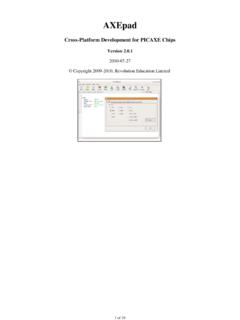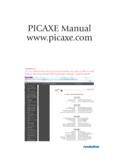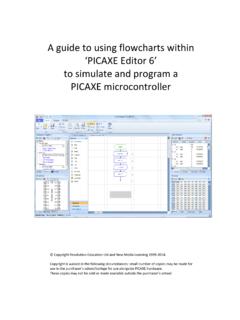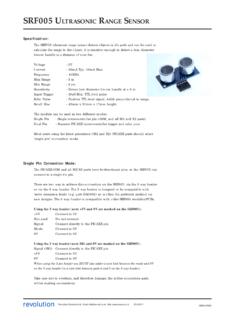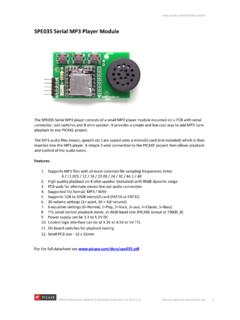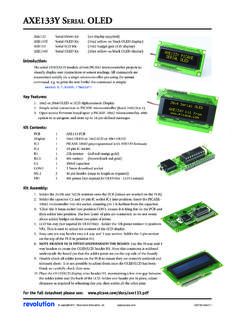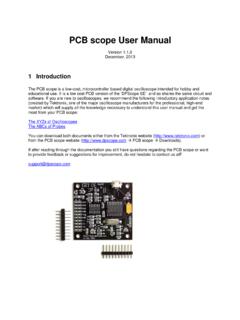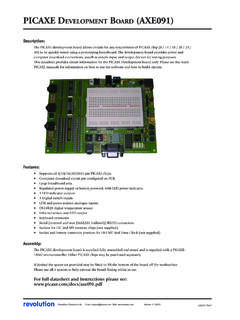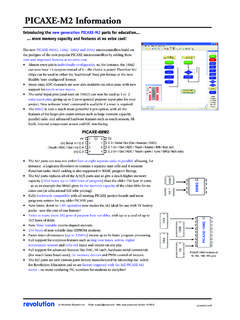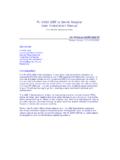Transcription of Contents
1 MICROCONTROLLER interfacing CIRCUITS. 1 section 3. Contents About this manual .. 2. Microcontroller interfacing Circuits .. 3. What is a PIC Microcontroller? .. 3. What is a picaxe microcontroller? .. 3. interfacing to the picaxe Microcontroller .. 4. Note on the BASIC Code Samples .. 5. Note on Component Selection .. 5. Standard interfacing Circuits .. 6. Standard Circuits 1 - The Transistor interfacing circuit .. 6. Standard Circuits 2 - Using a Darlington Driver IC .. 7. Standard Circuits 3 - The Relay interfacing circuit .. 8. Standard Circuits 4 - The Power MOSFET interfacing circuit .. 8. Output Device interfacing .. 9. Output Device 1 - Light Emitting Diode (LED) .. 9. Output Device 2 - Signal Lamp .. 1 0. Output Device 3 - Buzzer .. 1 0. Output Devices 4 - Piezo Sounder & Speaker.
2 1 1. Output Devices 5 - Solar & DC Toy Motors .. 1 2. Output Device 6 - Unipolar stepper motor .. 1 5. Output Device 7 - Bipolar Stepper motor .. 1 7. Output Device 8 - Radio Control Servo .. 1 9. Output Device 9 - Counter module .. 2 0. Output Device 10 - Seven Segment Display .. 2 1. Output Device 11 - Solenoid & Solenoid Valves .. 2 4. Output Device 12 - Smart Wire & Smart Springs .. 2 5. Input Device interfacing .. 2 6. Input Device 1 - Switches .. 2 6. Switch Bounce .. 2 7. Input Device 2 - Potentiometer .. 2 8. Input Device 3 - Light Dependant Resistor (LDR) .. 2 9. Input Device 4 - Thermistor .. 3 0. Advanced Component interfacing .. 3 1. Advanced interfacing 1 - LCD Display .. 3 1. LCD Characters .. 3 1. A Simple LCD Program .. 3 7. More Advanced LCD Program .. 3 8. Standard LCD Sub-Procedures (Direct Connection).
3 3 9. Advanced interfacing 2 - Serial interfacing to a Computer.. 4 3. Computer Communication Software .. 4 3. revolution Revolution Education Ltd. Version 12/2010. Web: 1. MICROCONTROLLER interfacing CIRCUITS. 2 section 3. About this manual Please note an update version of this manual is under preparation. See for latest version The picaxe manual is divided into three separate sections: section 1 - Getting Started ( ). section 2 - BASIC Commands ( ). section 3 - Microcontroller interfacing circuits ( ). This third section provides general microcontroller interfacing circuits, and example programs, for most common input/output transducers used within microcontroller circuits. For general information on getting started with the picaxe system please see section 1 of the manual. No prior understanding of microcontrollers is required.
4 A series of tutorials introduces the main features of the system. For more specific information, syntax and examples of each BASIC Command please see section 2 BASIC Commands'. The software used for programming the picaxe is called the Programming Editor'. This software is free to download from This manual was prepared using Version of the Programming Editor software. Please ensure you are using this version (or later) of the software, as earlier versions may not support all the commands and features described. The latest version of this document is available on the picaxe website at If you have a question about any command please post a question on the very active support forum at this website. revolution Revolution Education Ltd. Version 12/2010. Web: 2. MICROCONTROLLER interfacing CIRCUITS.
5 3 section 3. Microcontroller interfacing Circuits What is a PIC Microcontroller? A PIC microcontroller is a single integrated circuit small enough to fit in the palm of a hand. Traditional' microprocessor circuits contain four or five separate integrated circuits - the microprocessor (CPU) itself, an EPROM program memory chip, some RAM memory and an input/output interface. With PIC microcontrollers all these functions are included within one single package, making them cost effective and easy to use. PIC microcontrollers can be used as the brain' to control a large variety of products. In order to control devices, it is necessary to interface (or connect') them to the PIC. microcontroller. This section will help to enable those with limited electronics experience to successfully complete these interfacing tasks.
6 What is a picaxe microcontroller? A picaxe microcontroller is a standard Microchip PICmicro microcontroller that has been pre-programmed with the picaxe bootstrap code. The bootstrap code enables the picaxe microcontroller to be re-programmed directly via a simple serial connection. This eliminates the need for an (expensive) conventional programmer, making the whole download system a very low-cost simple serial cable! The pre-programmed bootstrap code also contains common routines (such as how to generate a pause delay or a sound output), so that each download does not have to waste time downloading this commonly required data. This makes the download time much quicker. As the blank microcontrollers purchased to make' picaxe microcontrollers are purchased in large volumes, it is possible for the manufacturer to program the bootstrap code and still sell the picaxe microcontroller at prices close to standard catalogue process for single un-programmed PIC microcontrollers .
7 This means the cost of the picaxe microcontroller to the end user is very economical. revolution Revolution Education Ltd. Version 12/2010. Web: 3. MICROCONTROLLER interfacing CIRCUITS. 4 section 3. interfacing to the picaxe Microcontroller This section explains how to interface many different input and output devices to the picaxe microcontroller. Explanations of BASIC commands are provided in the Commands section (available separately). The interfacing circuits can also be used with any other PIC microcontrollers such as the PIC16F84A, although these microcontrollers may require programming in assembler code. This section is split into four subsections: Introduction to standard' interfacing circuits Output Device interfacing Input Device interfacing Advanced Component interfacing revolution Revolution Education Ltd.
8 Version 12/2010. Web: 4. MICROCONTROLLER interfacing CIRCUITS. 5 section 3. Note on the BASIC Code Samples Simple BASIC code examples are provided within each subsection. The samples are not complete' programs but sections of code that can be included within a main program when using that particular component. When using these code samples it must be remembered that: 1. Each pin should be set up as an input or output before using the code (stamp users only). 2. If the hardware pins are changed from those given in the circuit diagrams it will be necessary to modify the pin numbers in the code. 3. Any let dirs =' or let pins =' commands will adjust all 8 pins, in the port. 4. Try to keep variables independant of each other. If a sub-procedure uses a variable, do not use the same variable anywhere else in the code.
9 If the same variable must be used again, make sure there is no way it can clash with any other part of the code. This is the most common way of adding hard-to-find'. bugs into software code. Note on Component Selection For convenience and ease of understanding, a single device has been adopted when using standard interfacing components such as transistors and MOSFETS. For instance, the standard' transistor selected is the darlington device BCX38C. This does not mean that this device is the only transistor that can be used in all the transistor circuits, as it is not, but it is chosen because it is suitable for the majority of project work applications. All components listed are common devices that can be purchased from most electronics distributors. revolution Revolution Education Ltd. Version 12/2010.
10 Web: 5. MICROCONTROLLER interfacing CIRCUITS. 6 section 3. Standard interfacing Circuits Standard Circuits 1 - The Transistor interfacing circuit Many output devices will require a transistor switching circuit . In most cases a darlington pair formed from two transistors is ideal. V+. Back EMF Output suppression device diode 1N4001. 1k Pin BC548B. BC639. 0V. However this circuit requires that two separate transistors are used. It is possible to buy a device that contains the two transistors in a single package. This transistor is called the BCX38C, and can switch currents up to 800mA. This is the transistor used in all the circuits through this book. V+. Output device 1k Pin BCX38C. 0V. Note that it is usual to connect a back emf suppression diode across the output device. This is essential with devices such as relays, solenoids and motors which create a back emf when power is switched off.
